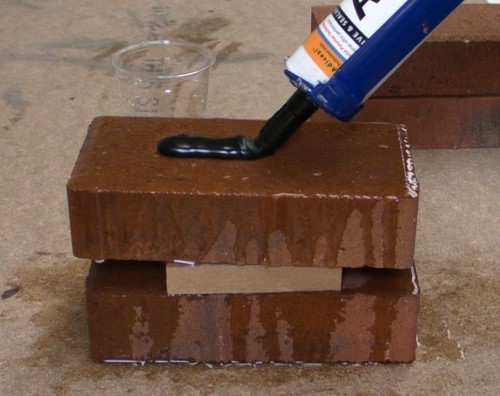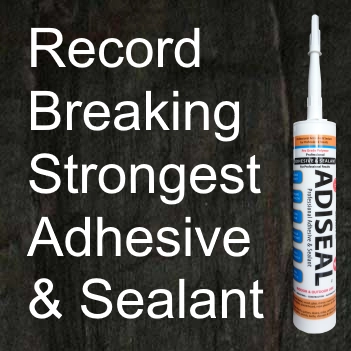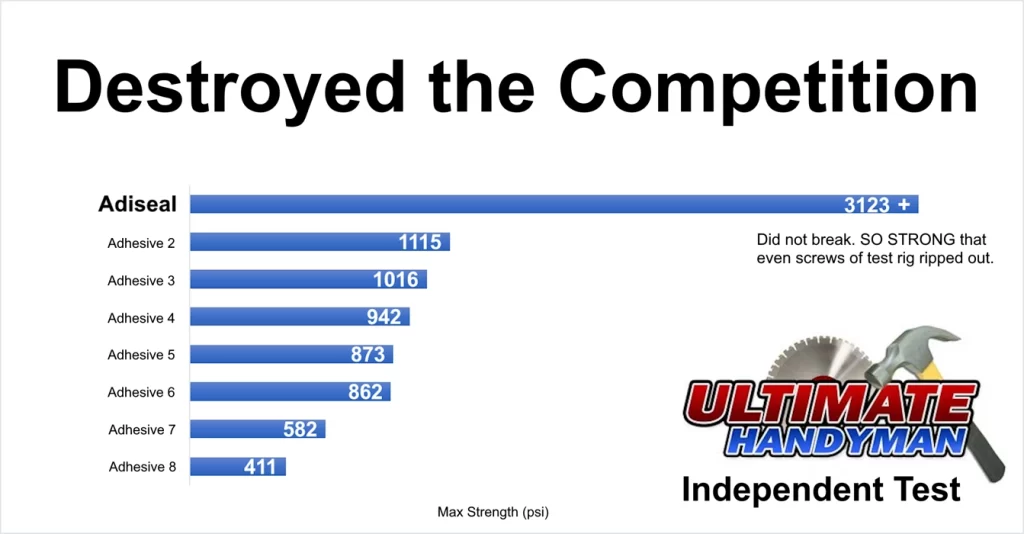Glue Brick
Brick Adhesive: Strong Bond on Brick, Stones, Slabs, Masonry
Adiseal is a high-performance brick adhesive to glue brick to different construction and building materials. For brick bonding applications, Adiseal provides a high-strength, flexible, heavy-duty and waterproof bond on brick. Adiseal masonry adhesive provides strong adhesion when sticking wood to brick, metal to brick, stone to brick, plastic to brick and more. It is suitable for both interior applications as well as an exterior brick adhesive.
- What is the best brick adhesive?
- How to stick wood to brick
- How to attach metal to brick
- Glue for brick
- Exterior brick adhesive

What is the best brick adhesive?
Strongest adhesive in independent test
In an independent adhesive strength test by Ultimate Handyman, Adiseal outperformed the competition by over 3 times. The screws holding the test rig down even began to rip out, necessitating the termination of the Adiseal test.


| Product | Max pressure when adhesive bond broke (psi) |
| Adiseal | 3123 + psi |
| SupaBond | 1115 psi |
| Tec 7 | 1016 psi |
| HB42 | 942 psi |
| Loctite PL Premium | 873 psi |
| Gorilla Grab Adhesive | 862 psi |
| Bond It PU18 | 582 psi |
| Bond It Save Nails | 411 psi |
Instant grab adhesive
When attempting to bond brick, Adiseal brick adhesive offers high initial grab, but for even greater initial gripping power, consider Adiseal Hi-Grab adhesive. Both construction adhesives provide a similar final brick bond strength, but Adiseal Hi-Grab offers an exceptionally strong initial hold. The example below illustrates the remarkable initial grip of Adiseal brick adhesive sealant on both dry and wet brick surfaces. We poured water over the brick before applying the adhesive on top of the wet surface. We then lifted up the wet brick straight away with another brick to demonstrate the high adhesive grab of Adiseal.


How to stick wood to brick
How to stick wood to brick.
- Prepare the Surfaces
Clean both wood and brick surfaces thoroughly, eliminating dust, dirt, and loose particles. Use a clean cloth or brush to remove debris. For finer dust, consider using a painting brush.
- Apply the Adhesive
Apply enough adhesive to create a solid bond but avoid using excessive amounts that may squeeze out from the edges when pressure is applied.
- Position the Wood on the Brick
Carefully position the wood onto the brick, aligning it with the desired location. Apply firm and even pressure to ensure good contact between the wood and the brick surface.
- Secure the Wood
If necessary use clamps or temporary supports to hold the wood in place while the adhesive cures. This will prevent the wood from sliding or shifting before the adhesive sets.
- Remove Excess Adhesive
If any adhesive squeezes out from the edges of the wood, use a putty knife or a damp cloth to remove it before it fully cures.
- Allow Sufficient Curing Time
Give the adhesive enough time to fully cure as per the manufacturer’s instructions. Avoid putting excessive stress or load on the wood during this curing period.
Tips
When attaching wood to brick, it’s important to consider that wood can absorb moisture from the air and expand or contract as a result. For this reason a flexible adhesive like Adiseal is recommended to glue brick to wood.
Tip: To store Adiseal once opened, leave about 1cm worth of product out of the nozzle and store the tube upright in a cool dry place. Adiseal requires moisture for it to cure. The exposed part out of the nozzle will cure creating a cap. To re-use Adiseal, pull the cured part out or cut the nozzle until the uncured part is reached.
How to attach metal to brick
For strong and lasting metal-to-brick bonds, Adiseal is an excellent choice, offering a waterproof, flexible bond. Clean surfaces are crucial for optimal bonding.
Some metals might have an oil coating to prevent rust, which should be removed before applying the adhesive. Adisolve effectively eliminates oil, grease, tar, and stubborn deposits.
Lightly scratching the metal surface can improve adhesive adhesion. After scratching, clean the surface to remove loose debris.
For safety with extra heavy metal items or vertical/overhead bonding applications, we recommend using mechanical fixings alongside Adiseal for extra safety. Follow steps (1 to 6) mentioned above to get a good strong bond.
How to stick plastic to brick
When bonding plastic to brick, Adiseal creates a robust and enduring bond. Clean the plastic surface thoroughly to remove dirt, dust, oil, or grease before applying the adhesive. Lightly scratching the plastic surface can enhance adhesion by increasing the surface area, ensuring a stronger bond. Adiseal works well for bonding brick with various plastic like PVC, but isn’t compatible with materials such as polypropylene or polyethylene.
Follow the aforementioned steps (1 to 6) for the best outcome. Adiseal is also suitable for adhering artificial grass to brick surfaces.
How to bond stone, tile, masonry, ceramic & concrete to brick
To bond stone, tile, masonry, ceramic, and concrete to brick bonding, follow the steps outlined above. However, due to the weight of these items, it’s more likely that temporary supports will be needed. Alternatively, the Adiseal Hi-Grab adhesive is a suitable option to avoid using temporary supports.
Adiseal is an effective adhesive for sticking various types of stone, including marble, granite, travertine, and slate, as well as many other types of stones.
Glue for brick
It is also possible to glue to brick using our Adiglue product. However, it’s important to note that Adiglue is less flexible and not as strong as Adiseal construction adhesive and construction sealant.
To demonstrate the bonding strength of Adiglue on brick, we conducted tests by gluing bricks together and attaching MDF wood to the bricks. It’s essential to seal the bricks and MDF with Adiglue Activator before applying Adiglue to prevent them from absorbing the liquid adhesive. Unlike our construction adhesive Adiseal, sealing of porous materials like brick is necessary for Adiglue.

Glue brick and other items with Adiseal
Exterior brick adhesive
Adiseal is an outstanding choice for an exterior brick adhesive, given its flexibility, UV resistance, and waterproof properties.
Pro tip: When there’s a possibility of water running behind the item, it’s advisable to apply the exterior brick adhesive in thin vertical strips. This allows water to run down rather than accumulating on top of the adhesive, which can freeze and expand in cold temperatures, exerting additional pressure on the adhesive.
Colours
Adiseal adhesive and sealant is available in the following colours:
- White adhesive and white sealant
- Black adhesive and black sealant
- Grey adhesive and grey sealant
- Clear adhesive and clear sealant
- Brown adhesive and brown sealant
Adiseal can also be manufactured in any RAL colour.
Mechanical fixings on brick
You can also attach items to brick using mechanical fixings by drilling into the brick. Our Adiseal Ultimate masonry drill bit and multi-material drill bit are exceptionally fast when used with a non-hammer function drill. In our test, drilling into brick with a basic non-hammer cordless drill, the Adiseal Ultimate masonry and multi-material drill bit drilled as fast as a corded SDS hammer drill. Notably, the SDS hammer drill ended up breaking the brick, a common issue with hammer drills.

Where to buy brick glue
In the UK, to buy brick glue adhesive, please contact us for details of your local stockist.
For other countries, please try www.guglue.com
Frequently Asked Questions About Brick Glue
Adiseal is the best adhesive to use on brick. It has proven to be the strongest adhesive in an independent test. Adiseal is a versatile adhesive that is flexible, waterproof, high gap fill, high grab, UV resistant, and can bond almost any type of material to brick.
To remove brick adhesive, you can use a sharp tool such as a knife or chisel. However, it’s important to exercise caution and not damage the brick surface. Most chemical adhesive removers are not effective on brick adhesive that is not solvent-based.
In most cases, brick is porous and can soak up liquid glue or adhesive. However, Adiseal adhesive and sealant does not require brick to be sealed beforehand, as it will not soak into the brick.
If you have a loose brick, Adiseal can be used to glue it back into place. Adiseal creates a long-lasting, flexible bond that will keep the brick in place. The Adiseal Hi-Grab product is perfect for this task as it provides a higher initial grab. However, it’s important to note that the professional method for fixing loose bricks is to use mortar.
To choose the right brick adhesive, consider factors like the materials you’re bonding, the application’s environment (interior or exterior), and the required strength. Adiseal is a versatile option suitable for various materials, both indoors and outdoors, providing strong adhesion to bricks.
Yes, it’s important to prepare the brick surface by ensuring it is clean, dry, and free from dust, debris, or loose particles. This helps to promote a better bond between the adhesive and the bricks.
